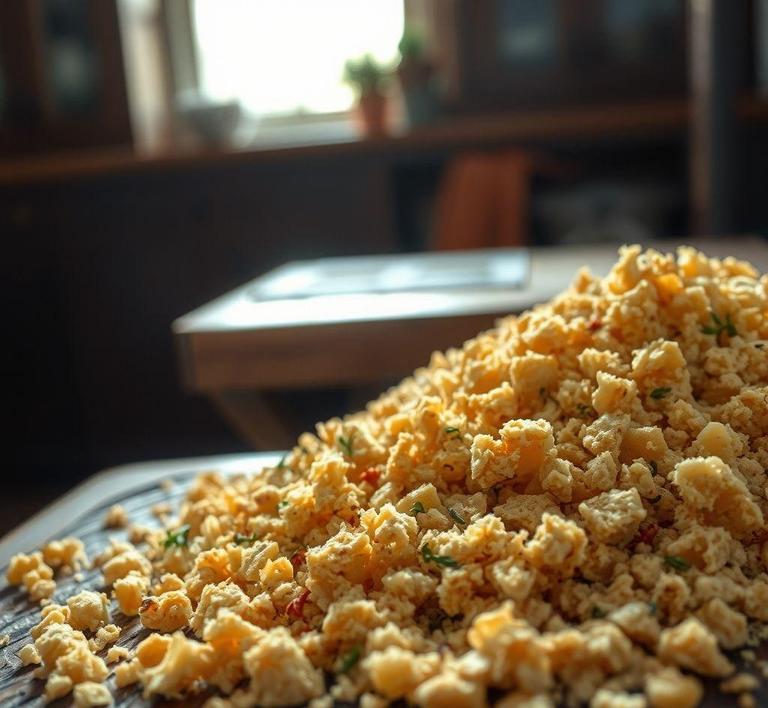Refreezing breadcrumbs might not be something most people think about, but it can be a real lifesaver when you’re trying to minimize food waste or keep extra breadcrumbs on hand for future use. Whether you’ve made too much or just want to store some for later, refreezing breadcrumbs can help maintain their freshness and texture if done correctly. In this guide, we’ll walk you through everything you need to know-how to properly refreeze them, tips to keep them crisp, and when it’s best to use the refrozen breadcrumbs in your favorite recipes. So, if you’ve got a surplus of breadcrumbs in your pantry, don’t toss them-learn how to keep them for later use!
Can You Refreeze Breadcrumbs?

Breadcrumbs are a staple in many kitchens, used in a variety of dishes from breading for fried foods to adding a crunchy topping for casseroles. But what happens when you’ve bought too many breadcrumbs or made an excess of homemade ones? Can you refreeze breadcrumbs after they’ve been thawed or previously frozen? The answer is yes, you can refreeze breadcrumbs, but with some caveats.
The main issue with refreezing any food, including breadcrumbs, lies in the changes to texture and quality caused by moisture. Once breadcrumbs are frozen, they become brittle and absorb any moisture in the freezer, leading to potential clumping or a softening effect when thawed and refrozen. However, if done properly, you can preserve most of their use in future recipes.
Understanding the process and handling of breadcrumbs during freezing and refreezing can help you maintain their utility and prevent them from going stale or soggy. The key is to freeze them in smaller portions and ensure they are kept in an airtight container to limit the introduction of moisture that causes degradation. So, while refreezing is possible, knowing the right technique makes all the difference.
How To Refreeze Breadcrumbs?
Refreezing breadcrumbs requires a bit of attention to detail to avoid ruining their texture and quality. Here’s a step-by-step guide to do it correctly:
1. Proper Storage Before Freezing
Before you even consider refreezing breadcrumbs, the initial freezing process is crucial. If you’re freezing homemade breadcrumbs, ensure that they are completely cooled and dry. Any moisture left in the breadcrumbs will lead to clumping and may make them soggy when defrosted and refrozen. If you’re dealing with store-bought breadcrumbs, they typically come in a tightly sealed bag, which helps maintain their crisp texture.
2. Portion Control
One of the best ways to manage breadcrumbs for freezing and refreezing is to portion them out. Use resealable freezer bags or small airtight containers to store breadcrumbs in smaller quantities. This way, you can take out only what you need without disturbing the entire batch, which reduces the need to refreeze large amounts at once.
3. Freezing Process
Place the breadcrumbs in a single layer in a zip-top freezer bag, squeezing out as much air as possible. For containers, use a plastic or glass airtight container, but leave a small amount of headspace to accommodate expansion as the breadcrumbs freeze. Label the containers with the date so you know when they were frozen. This is important for managing freshness and ensuring you use them within an acceptable time frame.
4. Thawing Before Refreezing
When you need to use your frozen breadcrumbs, it’s important to let them thaw properly. Remove the desired portion of breadcrumbs from the freezer and leave them in the fridge to thaw slowly. If you need them quickly, you can place them on a baking sheet and gently warm them in the oven for a few minutes. Never thaw breadcrumbs at room temperature or in the microwave, as this could introduce moisture and affect their texture.
5. Refreezing The Thawed Breadcrumbs
Once your breadcrumbs are thawed, you can refreeze them, but they should be handled delicately. Make sure to store them in an airtight container or resealable bag, and take care to remove all air before sealing. Keep the portion sizes small to ensure you only defrost what you need for future use. If you plan on refreezing a significant amount of breadcrumbs, it might be worth considering baking them again in the oven for a few minutes to dry them out before storing them back in the freezer.
Quality Impact
While refreezing breadcrumbs is possible, the quality may decline over time with each cycle. The primary impact of refreezing breadcrumbs is on texture and taste. Here’s how it can affect them:
1. Texture Changes
Breadcrumbs rely on a delicate balance of dryness and crispness. When you freeze them, moisture from the environment or within the breadcrumbs can affect their crunchiness. Upon thawing and refreezing, this moisture can create soft, soggy crumbs that no longer provide the crispy texture desired in recipes. The refreezing process causes the small ice crystals that form during freezing to break down the cell structure of the breadcrumbs, leading to a loss in their original crispness.
2. Flavor Deterioration
Breadcrumbs, like many other food items, lose some of their flavor profile with each freezing cycle. Although they won’t spoil per se, the exposure to freezing and thawing can lead to a muted flavor. This is especially true for homemade breadcrumbs, which may have absorbed additional seasonings, herbs, or spices. Over time, these flavors can fade when frozen and refrozen, making the breadcrumbs less impactful in recipes.
3. Increased Risk Of Stale Bread
Refreezing breadcrumbs that are made from stale bread may result in an even staler product. When bread is frozen initially, moisture loss occurs. If you freeze and refreeze stale bread to make breadcrumbs, the process could amplify the staleness, leading to a product that is less pleasant when baked or cooked. This will be especially noticeable in recipes where the texture of the breadcrumb is key, such as breaded chicken or in stuffing.
Refreezing breadcrumbs is entirely feasible, but it requires proper handling to preserve their texture and quality. While it may not yield the same crispness as freshly frozen breadcrumbs, careful storage and portioning can minimize the impact on their taste and texture. Be mindful of the moisture content and freeze in small batches to ensure that you are only refreezing the breadcrumbs that will be used immediately.
However, the best practice for preserving their quality over time would be to freeze them only once and try to use them within a reasonable period. This will help avoid the degradation of flavor and texture, keeping your breadcrumbs as close to their original state as possible. As with most frozen foods, once they are thawed and refrozen, the degradation process begins. If you’re looking to maintain that satisfying crunch and fresh taste, it’s ideal to use frozen breadcrumbs as quickly as possible after defrosting.
Is It Safe To Refreeze Breadcrumbs?
Breadcrumbs, whether they are fresh, homemade, or store-bought, are a pantry staple that often find themselves lingering in the kitchen, awaiting their moment to shine in recipes. But what happens when you find yourself with extra breadcrumbs, or you mistakenly thaw more than you need? Is it safe to refreeze them?
The short answer is yes, you can refreeze breadcrumbs, but with certain caveats. Unlike meats or dairy, which are more sensitive to bacteria growth when refrozen, breadcrumbs have a much lower moisture content and are less prone to spoilage. However, the quality of the breadcrumbs can decline significantly after multiple freezing and thawing cycles. The main issue with refreezing breadcrumbs isn’t safety, but rather texture and flavor.
Breadcrumbs are essentially dried crumbs of bread, and when exposed to moisture from thawing or condensation, they can absorb the water, making them soggy. Freezing them a second time after they have absorbed moisture can cause them to become clumpy and less crisp. This is particularly true for homemade breadcrumbs or those made from softer breads, as they contain higher moisture content than commercially packaged breadcrumbs.
Therefore, while refreezing breadcrumbs won’t inherently pose a health risk, their quality might be compromised, especially after several freeze-thaw cycles. For optimal results, it’s advisable to freeze breadcrumbs in small, manageable portions that can be used in a single go.
Signs That Breadcrumbs Should Not Be Refrozen
There are several indicators that will tell you whether the breadcrumbs have gone past the point of safe or advisable refreezing:
- Excessive Moisture: If you notice any moisture or condensation inside the packaging or storage container, it’s a sign that the breadcrumbs have absorbed too much water. Refreezing these breadcrumbs can result in a soggy, unappetizing texture, making them unsuitable for later use.
- Off Smell: Like any food item, breadcrumbs can go bad over time. If you detect any sour or rancid odors, this is a clear sign that they should not be refrozen. This might happen if the breadcrumbs have been exposed to moisture for too long, allowing bacteria or mold to develop.
- Color Changes: Fresh breadcrumbs are typically a pale, golden brown color. If you notice any significant darkening or discoloration, particularly if there are mold spots, this indicates spoilage, and you should not refreeze them.
- Clumping: Breadcrumbs should be loose and free-flowing. If they start to form clumps due to moisture absorption, it’s a sign they’ve been thawed and exposed to the elements for too long. Clumpy breadcrumbs won’t perform well in recipes, and refreezing them can lead to further deterioration.
- Taste Alterations: A slight change in taste, particularly a stale or off flavor, is a red flag. If your breadcrumbs taste stale after thawing, refreezing them will only make the situation worse.
Common Refreezing Mistakes
There are a few common mistakes people often make when refreezing breadcrumbs that can affect both the texture and quality of the breadcrumbs:
- Not Storing Them Properly Before Refreezing: If breadcrumbs aren’t stored properly before they’re refrozen, their texture can suffer. Using airtight containers or heavy-duty freezer bags is a must. The breadcrumbs should be kept in a dry, cool environment before being refrozen. If breadcrumbs are exposed to air, they’ll dry out and lose their fresh texture, becoming overly hard and crunchy.
- Refreezing Multiple Times: Every time you freeze and thaw breadcrumbs, the texture degrades. Refreezing them multiple times can result in a crumbly, dry product that’s no longer useful in recipes that require a certain crispness or texture.
- Freezing Breadcrumbs When Wet or Moist: Freezing breadcrumbs that have any moisture from either thawing or storage will lead to clumping when thawed again. This is one of the biggest mistakes people make. It’s important to let breadcrumbs cool and dry thoroughly before freezing.
- Freezing in Large Quantities: When breadcrumbs are frozen in large portions, you’re more likely to thaw and refreeze them several times, which accelerates quality degradation. It’s better to freeze breadcrumbs in smaller, single-use portions that can be easily accessed without needing to refreeze them.
Tips And Tricks
To help preserve the texture, flavor, and safety of your breadcrumbs, here are some helpful tips and tricks:
- Freeze in Small Portions: One of the best ways to prevent the need for refreezing is to freeze breadcrumbs in small, single-use portions. Consider dividing your breadcrumbs into meal-sized portions, making it easier to use only what you need.
- Use a Freezer Bag with a Zip Closure: A good quality freezer bag is essential for keeping breadcrumbs fresh. Remove as much air as possible from the bag before sealing it. This prevents freezer burn and helps retain the breadcrumbs’ original texture.
- Store in an Airtight Container: For homemade breadcrumbs, ensure they’re stored in an airtight container, as this helps maintain their crispness. If you’re storing them for an extended period, a vacuum-sealed bag is even better.
- Dehydrate Before Freezing: If you’re making homemade breadcrumbs, consider dehydrating them in the oven before freezing. This helps remove excess moisture, allowing them to freeze better and retain a crisp texture when thawed.
- Label and Date: Always label your frozen breadcrumb packages with the date of freezing. This allows you to keep track of how long they’ve been stored and helps avoid keeping them in the freezer for too long.
- Freeze Before Using in Recipes: If you’re using breadcrumbs as a topping or in a coating for dishes like chicken or fish, consider freezing the breadcrumbs before incorporating them into the recipe. This preserves their crispiness and freshness when cooked.
Conclusion
Refreezing breadcrumbs is technically safe, but it’s a process that can significantly impact their texture, flavor, and overall quality. Breadcrumbs, with their dry and crumbly nature, are prone to absorbing moisture, which can cause them to become soggy and clumpy if frozen and thawed multiple times. As long as you handle them properly-freezing in small, airtight portions, and avoiding repeated freeze-thaw cycles-you can preserve their freshness for future use.
Always be cautious of signs like moisture, discoloration, or off smells, as these indicate that the breadcrumbs have deteriorated beyond the point of safe refreezing. With a bit of care and attention, you can keep your breadcrumbs in top condition and enjoy their crisp, versatile texture for months to come.


